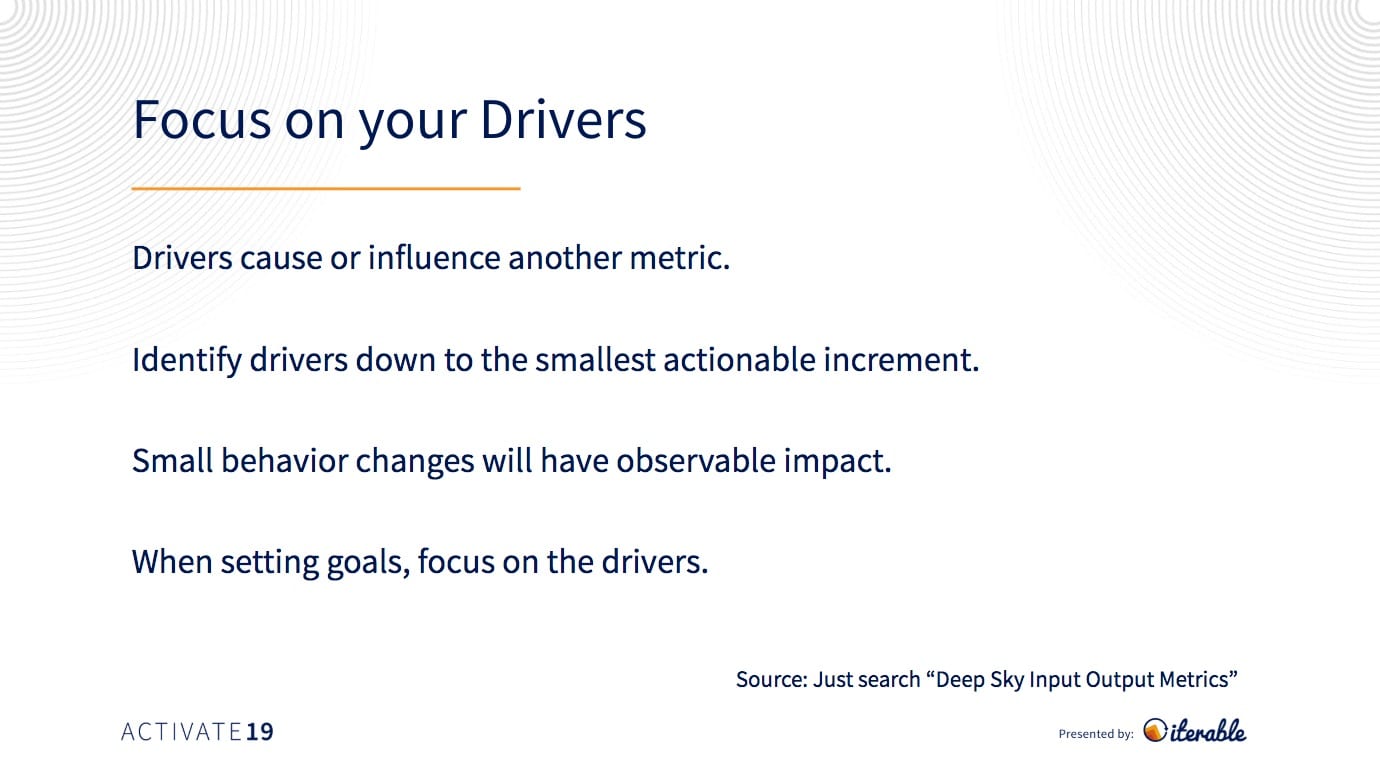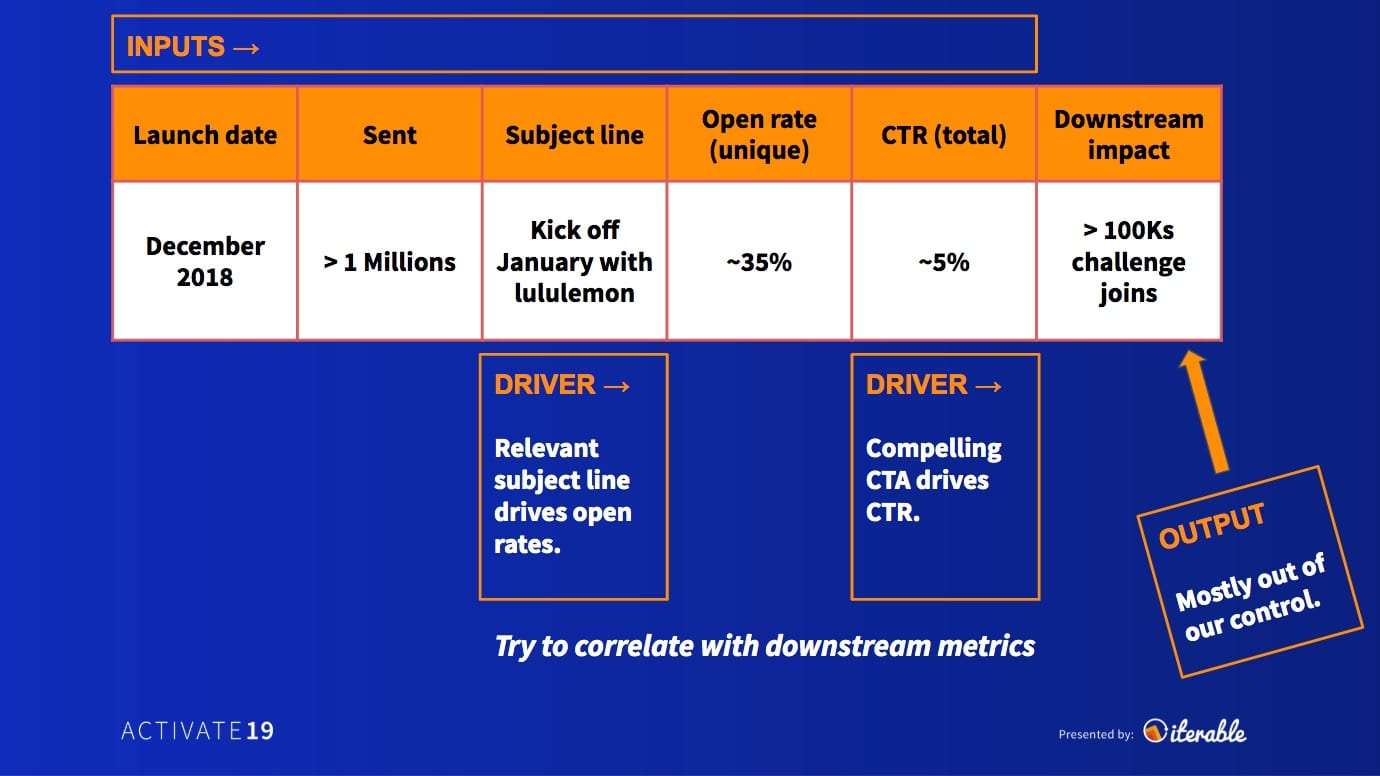In the world of the growth marketing, we’re constantly at odds with prioritizing where our time is invested—from building to testing and iterating upon a wide range of campaign elements, we hold the responsibility of all things engagement. With our customers’ experiences at stake, it’s incredibly important that we’re making the right business decisions and prioritizing the initiatives that make the most impact.
At Activate this year, Seth Bindernagel, Senior Director of Growth Marketing at Strava, a mobile app and website connect millions of runners and cyclists through the sports they love, shared his perspective on how growth marketers can drive more impact by focusing on the critical metrics within our control.
In our recap of his session below, we will cover some of the key takeaways from his presentation, but we absolutely recommend checking out the full video here.
Metrics That Matter Most
Seth started his session by talking about two types of critical metrics that drive the marketing funnel: input and output metrics. Input metrics focus on behaviors—opening an email, reading an article, or using a feature of your app. Output metrics, on the other hand, are components of a much bigger picture; think overall engagement, lifecycle stage efficacy, or revenue generation.


Both metric types matter immensely, but input metrics are the only ones within our control.
When we’re able to increase the growth of our input metrics, we tend to see positive correlation with broader downstream marketing success—this is critical to all growth marketers.
Input Drivers
If we’re investing in maximizing our input metrics, it’s critical we’re creating the right “drivers” that influence these metrics. Seth defines drivers as the different types of levers we pull that optimize our input metrics; these are the causes behind incremental changes that ripple downstream toward broader company impact.


Identify and then lean into the drivers within your control.
When growth marketers are testing subject lines, content, or workflows, we’re fine-tuning the drivers that influencing campaign and longer-tail engagement. Understanding the nuanced relationship between drivers and input metrics will help you better understand how you set the right types of goals for your different campaigns.
As you become more familiar with this approach, you’ll notice the different relationships between the behaviors you can control and those you can’t—your email can build the right drivers that commit customer action, but not necessarily how well your product experience keeps them active after that. Once it wanes, you’re responsible for stepping back in and re-engaging.
Lululemon + Strava: 40/80 Challenge
To further explore the concept of these metrics in action, Seth presented an overview of a joint campaign from earlier in the year between Strava and athletic apparel retailer, Lululemon.
There was a mutual interest to leverage each other’s positions as leading fitness brands to engage athletes through a shared pursuit of fitness and healthy lifestyles. Together, these two companies came together to create a challenge where athletes had to complete one of two different goals within a two-week period: run either 40 or 80 kilometers.


Get active in style with Strava and Lululemon.
Strava and Lululemon worked together to create a variety of email campaigns that would inspire their target athletes (input metrics) to join the challenge and boost brand affinity (output metrics).
Their growth teams wanted to do as much as possible to get their users right to the point where they take action to commit.
Lining Up the Metrics
As they started building their campaign, these were a few of the sample metrics and key drivers in play:
- Setting and executing on a campaign launch date
- Sending over a million emails to their databases
- Choosing preliminary subject lines, preheader text, headlines, and send times. These are all key drivers—elements within their control that they could test for open rate effectiveness.
- Reporting on unique open and click through rates. Key drivers included content and calls to action driving these rates.
- Observing the downstream impact of the campaign—the most critical output metric!


Breaking down the high-level success metrics from the Lululemon 40/80 campaign.
Having a clear understanding of the actions they needed to take to influence as much downstream campaign impact as possible helped them clearly focus their time, energy, and resources toward an effective campaign buildout. At the end of the day, their efforts were coordinated around doing everything within their power and align the campaign with success.
Strava’s comprehensive approach certainly paid off, too. Once the campaign had come to a close, they saw that more than 100,000 people joined their joint campaign. Even though that output metric was largely out of their control, their meticulous focus on input metric optimization resulted in positive correlation with the success of the downstream campaign event.
Your Input Matters!
Strava demonstrated that defining and familiarizing yourself with the input metrics at your campaign’s core help prioritize where to focus your efforts. Taking it one step further and identifying and testing your drivers will further optimize for potential success down the line.
The more in-tune you become with your input metrics, the better you can analyze any correlations existing between your efforts with your downstream results. Understanding (and then iterating upon) the relationship between the strategies driving your campaigns and the elicited responses of your customers brings new awareness for maximizing your marketing potential.
Watch Seth’s full session and dive into even great campaign details on the Activate website.
































